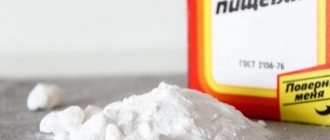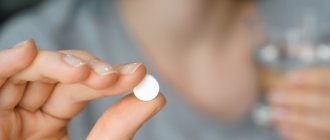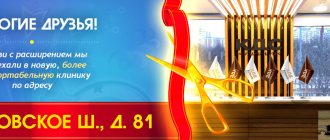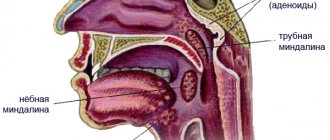Sodium bicarbonate (sodium bicarbonate, baking soda) is the most well-known symptomatic remedy for patients suffering from increased gastric secretion and who know what heartburn is. Heartburn is observed in acid-dependent diseases of the gastrointestinal tract, such as gastroesophageal reflux disease (GERD), gastric and duodenal ulcers.
To relieve heartburn, various groups of drugs are used, including antacids, which are divided into absorbable and non-absorbable. Sodium bicarbonate is an absorbable antacid.
How does baking soda affect the stomach?
The use of soda began in Ancient Egypt.
In the modern world, soda is used:
- at home;
- in cooking;
- in pharmacology, medicine.
There are several known methods that use soda to treat a number of diseases. Many people are interested in whether soda is harmful to the stomach? Let us list the properties that affect a person.
Positive effects on the stomach:
- cleanses of toxins and impurities;
- reduces the number of pathogenic bacteria;
- reduces acidity levels;
- is a mild pain reliever;
- reduces the amount of pepsin.
In addition to its positive effects, soda can be harmful to the stomach. This happens when you abuse a substance. If you regularly take more than 1 teaspoon of soda, you can harm the gastric mucosa. Therefore, you should not exceed the norm and remember the contraindications. If you have stomach problems, consult your doctor.
Gastric lavage for alcohol intoxication
06.11.2021
Alcohol intoxication occurs as a result of drinking alcoholic beverages. In the first stages of intoxication, gastric , which can be carried out using potassium permanganate, activated carbon, baking soda or table salt. Today, young people do not always understand the damage that drinking alcohol in large quantities causes to the body. In medical practice there is the term “alcohol intoxication”. A condition characterized as intoxication involves a change in the mental and physiological components of a person’s behavioral activity.
Depending on the severity of these changes, that is, the amount of ppm alcohol in the blood ,
There are several stages of alcohol intoxication:
- The mild stage involves a slight influence of alcohol, which may not have any effect on the person’s condition and behavior. In some cases, difficulties arise when driving a vehicle.
- The middle stage is associated with the loss of an objective assessment of reality. The person has disorders of speech and mental activity, and coordination of movements is impaired.
- At a severe stage of intoxication, there is a possibility of death. In this case, the blood must be more than 5.0%.
Despite the fact that today the sale and delivery of medicines is available to every patient, not everyone decides to take advantage of this opportunity. But you can eliminate the signs of alcohol intoxication in the early stages yourself at home.
A common method is gastric lavage , which is carried out using water with baking soda diluted in it or using a weak solution of potassium permanganate. Such measures allow you to remove toxic substances from the body. If the gag reflex is not caused independently, you should press on the root of the tongue with a finger or a teaspoon. In this case, the amount of liquid drunk should be sufficient to minimize the degree of intoxication. The procedure can be completed when the water leaving the stomach becomes clear. Timely rinsing prevents the absorption of toxic substances into the blood .
Nevertheless, the most popular and easiest to use is the well-known sorbent - activated carbon, which has the ability to detect and remove toxic compounds from the body. To achieve the desired effect, you usually need to drink up to ten tablets of charcoal with several glasses of water. To make it work faster, it is recommended to crush the tablets into powder and prepare a solution. To increase the body's resistance to harmful substances, special drugs, for example, Mexidol, can be used.
If potassium permanganate is used, it should be diluted until the color of the solution is light pink. To avoid burns to the mucous membrane, be sure to strain the resulting liquid through gauze folded in four layers. Thus, if small crystals of potassium permanganate do not dissolve due to weak stirring, they will not get inside.
Rinsing with table salt is also carried out taking into account certain proportions. Usually, three tablespoons of salt are taken for five to seven liters of water. The action of such a solution is based on spasm of blood vessels located at the exit from the stomach . As a result of this exposure, toxins cannot enter the intestines .
Published in Articles without category Premium Clinic
How to drink soda for gastritis
Baking soda is often used to relieve heartburn. The substance, entering the stomach, reduces its acidity. As a result, pain is relieved. However, experts recommend using baking soda only when no other treatment is available.
Patients with gastritis should drink soda solutions as rarely as possible, because under its influence the balance between acid and alkali in the body is disrupted.
The following symptoms may appear:
- thirst;
- weakness;
- convulsions.
As a result, the patient's condition may worsen.
For diseases of the stomach with low acidity, soda, when it enters the body, triggers chemical processes. It reacts with hydrochloric acid, resulting in the formation of water, gas, and carbonic acid. These processes can negatively affect the gastric mucosa, worsening the condition of a patient with gastritis.
Sodium bicarbonate (baking soda)
Sodium bicarbonate
(English
sodium bicarbonate
; synonyms:
sodium bicarbonate, sodium bicarbonate, baking soda, baking soda
) is an antacid that normalizes acid-base balance.
Sodium bicarbonate is a chemical substance
Sodium bicarbonate is an acidic sodium salt of carbonic acid. Chemical formula of sodium bicarbonate: NaHCO3. Sodium bicarbonate is a white, odorless, crystalline powder with a salty-alkaline taste. Sodium bicarbonate is stable in dry air, but decomposes slowly in humid air. Easily soluble in water to form alkaline solutions. The acidity of a five percent sodium bicarbonate solution = 8.1 pH. Sodium bicarbonate is practically insoluble in ethanol. Molecular weight 84.01. Sodium bicarbonate reacts with acids to form a salt and carbonic acid, which immediately breaks down into carbon dioxide and water.
Sodium bicarbonate - medicine
Sodium bicarbonate (this is its name in pharmaceuticals) is the international nonproprietary name (INN) of the drug. According to the pharmacological index, sodium bicarbonate belongs to the groups “Regulators of water-electrolyte balance and acid-base balance” and “Antacids”, according to ATC - to the group: “B05 Plasma-substituting and perfusion solutions” and has codes B05CB04 and B05XA02. In addition, in the group “A02 Drugs for the treatment of diseases associated with acidity disorders” there is a five-digit code “A02AH Antacids in combination with sodium bicarbonate”.
Sodium bicarbonate therapy for pregnant and nursing mothers
Due to the unwanted side effects of sodium (edema and weight gain), some experts advocate the use of alternative antacids that do not contain sodium bicarbonate in pregnant women. FDA Fetal Risk Category for sodium bicarbonate therapy is "C" (animal studies have shown adverse effects on the fetus and there have been no adequate studies in pregnant women, but the potential benefit associated with the drug in pregnant women may justify its use , despite the existing risk). Due to the lack of data on the excretion of sodium bicarbonate into breast milk, there are no restrictions for the treatment of breastfeeding mothers.
Baking soda is a traditional but dangerous remedy for relieving heartburn.
| All moods and voices Chewed down to one. Enough soda for heartburn! So this is your result, skill? B.L. Parsnip. "All moods and voices." 1936. |
Sodium bicarbonate is a traditional remedy for relieving heartburn, an absorbable antacid. Absorbed antacids are those that either themselves or the products of their reaction with gastric acid dissolve in the blood.
A positive quality of absorbed antacids is the rapid decrease in acidity after taking the medicine. Negative - short duration of action, acid rebound (increased secretion of hydrochloric acid after the end of the drug's effect), the formation of carbon dioxide during their reaction with hydrochloric acid, stretching the stomach and stimulating gastroesophageal reflux (see the figure on the right from the article by D.S. Bordin)
. Absorption of bicarbonates into the blood can lead to the development of systemic alkalosis, and their long-term use in combination with a dairy diet can lead to the development of Burnett's syndrome (milk-alkali syndrome).
After taking 3 g of sodium bicarbonate, the pH of the gastric contents remains above 3 pH units for only 75 minutes. The carbon dioxide formed during neutralization causes belching and bloating. As a rare complication after taking sodium bicarbonate, gastric rupture due to the sudden release of a large amount of gas has been described (A.V. Okhlobystin).
In the 19th century, “soda” was one of the most popular remedies for heartburn; for example, P.I. constantly took it. Chaikovsky.
Sodium bicarbonate in acid-suppressing drugs
Despite the negative attitude towards sodium bicarbonate as a means of relieving heartburn, it is sometimes included in medications intended to reduce acidity in the upper gastrointestinal tract, in sufficient quantities to be considered as another active ingredient (although the instructions for this sodium bicarbonate may be listed among the excipients rather than the active substances).
Proton pump inhibitors
.
There are two versions of the proton pump inhibitor Zegerid
.
Zegerid itself is prescription and over-the-counter Zegerid OTC
.
Zegerid is not registered in Russia, but Omez Insta
. Both medicines contain omeprazole and sodium bicarbonate. In the US, Zegerid is marketed as the only "immediate response" proton pump inhibitor that does not have the "overnight acid breakthrough" phenomenon. It is intended for relief of symptoms of gastroesophageal reflux disease, short-term (4-8 weeks) therapy of erosive esophagitis, confirmed by endoscopy, gastric and duodenal ulcers. The content of omeprazole and sodium bicarbonate in various dosage forms of these drugs is given in the table:
| Main Ingredients | Zegerid , capsule | Zegerid , capsule | Zegerid , sachet* | Zegerid , sachet* | Zegerid OTC , capsule | Omez Insta , sachet* |
| Omeprazole , mg | 20 | 40 | 20 | 40 | 20 | 20 |
| Sodium bicarbonate , mg | 1100 | 1100 | 1680 | 1680 | 1100 | 1680 |
Note.
*) The sachet contains powder for the preparation of a suspension for oral administration. Alginates.
The only medicine for the treatment of acid-related diseases from this group approved in Russia, as well as in the USA, is
Gaviscon
and its variants Gaviscon Forte and Gaviscon Double Action. In addition to the “main” active ingredient - sodium alginate, Gaviscon contains sodium bicarbonate and calcium carbonate. When sodium alginate enters the stomach, it quickly reacts with its acidic contents, resulting in the formation of an alginate gel that has an almost neutral acidity value (gel pH is about 7). The gel forms a protective barrier on the surface of the stomach contents, preventing the occurrence of gastroesophageal reflux. In case of regurgitation or reflux, the gel enters the esophagus, where it has a neutralizing effect on hydrochloric acid and pepsin that enter during reflux and additionally protects the mucous membrane of the esophagus. The content of sodium alginate and sodium bicarbonate in various dosage forms of Gaviscon is given in the table:
| Main Ingredients | Gaviscon , 10 ml suspension | Gaviscon , chewable tablet | Gaviscon forte , 10 ml suspension | Gaviscon Double Action , chewable tablet | Gaviscon Double Action , 10 ml suspension |
| Sodium alginate , mg | 500 | 250 | 1000 | 250 | 500 |
| Sodium bicarbonate , mg | 267 | 133,5 | — | 267 | 213 |
Sodium bicarbonate in other medicines
In addition to the medications described above for the treatment of acid-dependent diseases, sodium bicarbonate is included as an active ingredient, in particular, in the following medications:
- osmotic laxative Endofalk
, one sachet of which includes: macrogol 3350 52.5 g, sodium chloride 1.4 g, sodium bicarbonate 715 mg, potassium chloride 185 mg - osmotic laxative Lavacol
, one sachet of which includes: macrogol 4000 12.0 g, sodium sulfate anhydrous 1.0 g, sodium bicarbonate 0.6 g, sodium chloride 0.2 g, potassium chloride 0.2 g - antitussive drug Codelac
, one tablet of which contains: codeine 8 mg, sodium bicarbonate 200 mg, licorice root powder 200 mg, thermopsis lanceolate herb powder 20 mg - a drug for the treatment of cough that has a mucolytic and expectorant effect, Codelac Broncho
, one tablet of which contains: ambroxol hydrochloride 20 mg, sodium glycyrrhizinate 30 mg, thermopsis dry extract 10 mg, sodium bicarbonate 200 mg - solution for infusion with detoxification effect Gemodez-N
, 100 ml of which contains: medical povidone with a molecular weight of 8000 6 g, sodium chloride 550 mg, potassium chloride 42 mg, calcium chloride 50 mg, magnesium chloride anhydrous 500 mcg, sodium bicarbonate 23 mg
The use of sodium bicarbonate in the study of the stomach (Noller test)
The Knoller test (alkaline test) is performed to obtain information about the amount of hydrochloric acid in the patient’s stomach, the intensity of acid formation, and also, indirectly, the amount of gastric juice. The test is carried out simultaneously with the intragastric pH-metry
, 20 minutes after stabilization of acidity under basal conditions or 45 minutes after the administration of stimulants. At a pH equal to or higher than 4.0, the alkaline test is not performed.
The patient drinks 0.5 g of sodium bicarbonate dissolved in 30 ml of distilled water. Typically, the pH in the body of the stomach is recorded below 2.5. As a result of the introduction of alkali into the stomach, the pH values change to alkaline and remain at the same level for a certain time, and then, after some time, called “alkaline time,” they return to the original ones. The alkaline time determines the state of acid production in the patient’s stomach (S.I. Rapoport et al.):
| Assessment of hydrochloric acid production in the stomach | Alkaline time , min | |
| on an empty stomach | upon stimulation | |
| Sharply increased acid production | <10 | <5 |
| Increased acid production | 10–20 | 5–10 |
| Normal acid production | 20–25 | 10–15 |
| Reduced acid production | >25 | >15 |
The figure shows an example of a pH gram in
three sections of the stomach
(in the antrum - lower graph, in the body of the stomach - middle and in the cardiac section of the stomach closest to the esophagus - lower graph) of a patient with chronic superficial gastritis and high acidity in the antrum. Basal acidity is shown (the first 30 minutes, basal - that is, before any stimulation) and acidity after the alkaline test (AL) and histamine stimulation (HT).
Bicarbonates as a natural means of protecting the gastrointestinal tract from acid
In the stomach and duodenum, bicarbonate ions HCO3– are secreted by surface epithelial cells. Bicarbonates play a vital role in the digestive process, neutralizing hydrochloric acid and protecting the tissues of the digestive organs from its effects.
In an acidic environment, bicarbonate ions react irreversibly with hydrogen ions to form water and carbon dioxide:
H+ + HCO3– = H2CO3 = H2O + CO2
Bicarbonates, together with mucus, constitute the so-called pre-epithelial level of protection of the gastric mucosa. Mucus cannot protect the epithelium from H+ ions without bicarbonates constantly entering it, also secreted by the surface epithelium. With the help of bicarbonates, a pH gradient is maintained in the mucus: on the surface facing the lumen of the stomach, the environment is acidic, and on the epithelial cells it is neutral or slightly alkaline. Immediate mixing of bicarbonates with the acidic secretion in the lumen and neutralization does not occur: the mucus layer forms a barrier, due to which the pH gradient exists (T.L. Lapina).
Bicarbonates are also secreted by the ductal cells of the pancreas and, together with pancreatic juice, enter the duodenum, where they participate in the neutralization of hydrochloric acid (O.A. Sablin et al.).
Bicarbonate in mineral waters
Hydrocarbonate ions HCO3– are present in almost all natural mineral waters.
To determine them in water, GOST 23268.3-78 “Healing mineral drinking waters, medicinal table waters and natural table waters” is used. Methods for determining bicarbonate ions". According to GOST R 54316-2011. “Natural drinking mineral waters. General technical conditions" the content of bicarbonates is indicated on consumer packaging (on the labels of bottles of mineral water). Content of hydrocarbonates in some natural mineral waters (g/l):
- healing mineral waters:
- Nagutskaya-17 — 5.0–7.2
- Essentuki No. 17 — 4.9–6.5
- Nagutskaya-56 — 4.2–5.6
- Essentuki No. 4 - 3.4–4.8
- Narzan - 1.0–1.5
- Kashinskaya - less than 0.05
- Gelendzhikskaya 117 — 0.35–0.7
- Essentuki Novaya-55 - 0.2–0.35
Bicarbonate anions give mineral water an alkaline character and most often combine with sodium cations to form sodium bicarbonate. Sodium bicarbonate waters increase the alkaline reserve of the blood, have an antacid effect (by reducing the concentration of H+ ions), reduce pyloric spasm and accelerate the evacuation of gastric contents, which helps reduce pain and dyspeptic symptoms. Alkaline waters thin and help remove excess mucus, which is formed during inflammation in the gastrointestinal tract, urinary and respiratory tracts. In addition, they improve nucleic acid metabolism, reduce the formation of uric acid and promote the removal of excess from the body, alkalize bile and increase the secretion of bilirubin, cholesterol and mucus. In diabetes mellitus, these waters reduce hyperglycemia and increase tolerance to carbohydrates. And finally, in combination with bicarbonate, macro- and microelements, in particular iron, are better absorbed from the intestine (Baranovsky A.Yu. et al.).
Professional medical articles addressing the role of bicarbonates and sodium bicarbonate in gastroenterology
- Mikheev A.G., Nevsky D.I., Rakitin A.B., Rakitin B.V. Study of pH dynamics in alkaline dough // Izvestiya VUZov. North Caucasus region. Natural Sciences. – 2006. Special issue. – pp. 44–46.
- Sablin O.A., Grinevich V.B., Uspensky Yu.P., Ratnikov V.A. Stomach. Methods for studying alkaline secretion. Functional diagnostics in gastroenterology. St. Petersburg 2002
- Lapina T.L. Possibilities of medicinal effects on the cytoprotective properties of the gastroduodenal mucosa // Russian Journal of Gastroenterology, Hepatology, Coloproctology. – 2006. – No. 5. – volume XVI. – c. 2–7.
- Ushkalova E.A. Clinical pharmacology of modern antacids // Farmateka. – 2006. – No. 11. – p.1–6.
- Gelfand B.R. , Filimonov M.I., Mamontova O.A. and others. Prevention and treatment of stress damage to the gastrointestinal tract in patients in critical conditions // Methodological recommendations. - Moscow. - 2010. - 34 p.
On the website in the literature catalog there is a section “Antacids”, containing articles devoted to the treatment of diseases of the gastrointestinal tract with antacids. Back to section
Water and soda on an empty stomach, benefits or harm
There is a trend in folk medicine that uses soda to treat a variety of diseases, ranging from alcoholism to malignant tumors. Experts continue to debate about the effectiveness of these methods. Doctors believe that soda solutions on an empty stomach can do more harm than good. It is especially dangerous if taken regularly.
Some people drink soda cocktails to lose weight. A short-term effect is observed, but this is due to the chemical processes that soda triggers in the body. A person simply loses a certain amount of fluid. As a result, the weight returns quickly.
| Negative effects of soda | Positive effects of soda cocktails |
|
|
If it is necessary to use aqueous solutions, certain rules should be followed.
Recommendations for the preparation and use of soda solutions:
- You need to drink immediately after you wake up.
- After consuming the solution, at least half an hour should pass before eating. It is more useful if the interval is 1.5 hours. If you do not follow this rule, you can provoke the appearance of diseases such as gastritis and ulcers.
- If vomiting or diarrhea occurs after taking soda, then you need to stop this treatment.
- The maximum amount of soda consumed should be 1 teaspoon per glass of water.
- You should not dilute soda with mineral water.
- To prepare the composition, you need to use water at a temperature of 80-90 ° C, but you do not need to drink such a hot solution. Cool or add cold water.
- When treating with soda, it is necessary to take a break between courses.
- Soda can be dissolved in milk.
You can drink water and soda on an empty stomach, but not often. Experts say that a healthy person should not consume soda solution more than 2-3 times a week.
For treatment, it is recommended to choose more effective and safe means.
Baking soda for weight loss
Recently, many have begun to use soda as a means of reducing excess body weight. Studies have shown that the method of losing excess weight by drinking soda is not only ineffective, but also dangerous to health, since excess weight will not go away, and chronic diseases will worsen or even new ones will appear.
Obesity is a complex disease and has different causes, so resorting to soda does not make any sense. Miracles do not happen, and correction of body weight can be solved by establishing the causes of obesity in a particular person, maintaining a healthy lifestyle, proper nutrition, normal work and rest, and physical activity. WHO experts believe that soda cannot be a panacea and solve the problem of excess weight.
It is better to leave baking soda as a leavening agent for home baking!))










